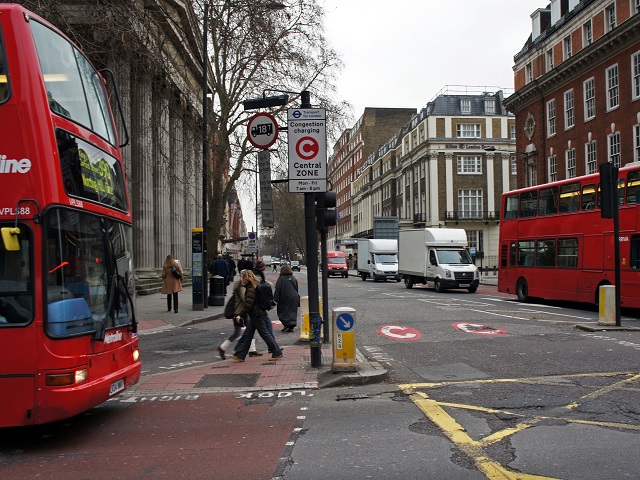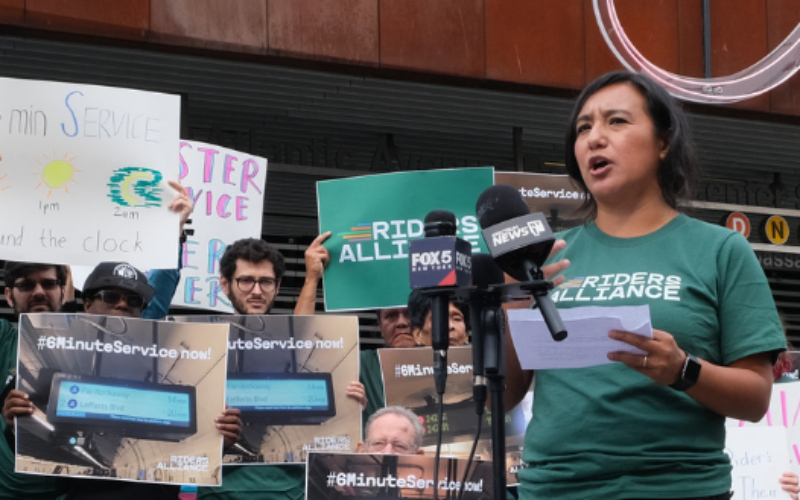
Congestion charge zone in London. Photo credit: TheCityFix
Expectation is mounting that Governor Cuomo will announce his plan for NYC congestion pricing in next week’s State of the State speech. If that happens, one thing we’re watching for – in addition to details like design of the pricing zone and the charging levels – is how the plan proposes to make transit more attractive as driving to the central business district becomes more expensive.
Inclusion of a transit service “carrot” with the stick of a congestion charge has been a prominent feature of major congestion pricing plans and proposals. London, Stockholm, and Mayor Bloomberg’s 2007/2008 congestion pricing plans all recognized the practical and rhetorical importance of adding transit service alongside the disincentive of road pricing. The challenge for New York today is that city subways are struggling to provide decent service and are increasingly viewed as an unreliable way to travel. Possible ways to address the problem lie in the timing of pricing’s implementation, and a focus on augmented bus service.
Before London switched on its congestion charge in 2003, it made major transit investments, focusing specifically on buses as the quickest way to increase capacity. Transport for London (TfL) provided an additional 350 buses into the city center during peak times, a 23% increase. Four new routes, using high-capacity articulated buses, provided some of that capacity. Higher service frequency and larger buses were also deployed on existing routes. Additionally, the second phase of an established program, the London Bus Initiative, was accelerated to provide more bus lanes, enforcement, and priority treatments. TfL also increased frequencies on specific Underground lines. These improvements, which began to hit the streets and tunnels shortly after Mayor Ken Livingstone took office in August 2000, effectively reduced car travel into London and increased bus ridership by 25%, all before the congestion charge was even introduced.
When Stockholm prepared to implement its congestion charge pilot, the city developed new bus routes, opened 2,800 park and ride spots at peripheral transit stations, and purchased 197 new buses. Transportation authorities also increased frequency and added capacity on existing routes where possible. The measures added up to a 6% jump in transit ridership after pricing was implemented.
The Bloomberg plan for New York, as modified during debate and review during 2007-2008, estimated that upon the start of congestion pricing, there would be 78,000 “diversions” from cars to transit within the five boroughs, and 6,000 diversions from the nearby suburbs. To handle this, the plan included the addition of 309 buses to the NYC fleet — a mixture of local, articulated, and express buses — eight new bus routes, bus lanes on bridges, and new bus rapid transit lines, with an emphasis on increasing bus connections to subway hubs and serving areas that generated the most vehicle trips. Additionally, the plan increased frequency along several subway lines. For diversions in suburban markets, the plan focused on addition of 58 express buses, new park & ride facilities, and expanded commuter rail service where possible.
Where does that leave a potential Cuomo plan? London and Stockholm were able to draw on significant national government resources, while Bloomberg’s plan had the good fortune of aligning with a new Bush Administration program to encourage “market-based” transportation initiatives. New York stood to gain about $350 million in new federal aid to purchase buses and increase transit service had it been able to move forward with congestion pricing.
The Cuomo administration will not enjoy this kind of outside assistance. However, what it has is time – it’s unlikely a New York congestion pricing proposal announced, debated and potentially legislated during 2018 will see a system of new road tolls ready for implementation in the next 18 or so months. The Governor can use this window to assemble resources to expand the bus fleet and identify other funding mechanisms. For example, a new fee on for-hire vehicle trips or miles, from taxis, Uber, Via and other companies, is very likely to play a role in any pricing proposal. The Bloomberg plan included a $1 surcharge on all taxi trips in the central business district. It’s possible the for-hire-vehicle fee could take effect before toll gantries and related congestion pricing systems are installed and turned on, providing a short-term new revenue source, perhaps combined with additional state (and city?) resources Cuomo can marshal to create new transit capacity.
The issue of course points to the serious urgency of executing the MTA’s stated Subway Action Plan. Getting subways back to 2014 or 2015 condition would not be the carrot for higher ridership a congestion pricing plan needs, but failing to reestablish a baseline of transit quality could prove a real political problem for a Cuomo congestion pricing plan. NYC subway ridership was about 12% higher in 2016 than it was when Bloomberg launched his push for congestion pricing, so the margins for adding riders without additional capacity and much better service are slim.
An updated version of the 2008 express bus plan, together with the numerous low-cost steps available to the MTA in the bus system reform agenda put forth by the NYC Bus Turnaround Campaign, from faster bus boarding to better route planning, are an obvious strategic direction this time around. Subway ridership during the past 12 months is off about 1%, but on city buses, the drop has been nearly 5%. While congestion pricing’s reduction of traffic should help bus performance in and near the central business district, the Governor needs to be able to point to real, implemented transit capacity additions before new tolls are switched on. The debate over congestion pricing will be sharp and possibly prolonged, so major vulnerabilities like the current state of transit in New York need to be squarely addressed in the Governor’s plan.
 On the Brink: Will WMATA’s Progress Be Erased by 2024?
On the Brink: Will WMATA’s Progress Be Erased by 2024?
The experience of being a WMATA rider has substantially improved over the last 18 months, thanks to changes the agency has made like adding off-peak service and simplifying fares. Things are about to get even better with the launch of all-door boarding later this fall, overnight bus service on some lines starting in December, and an ambitious plan to redesign the Metrobus network. But all of this could go away by July 1, 2024.
Read More Built to Win: Riders Alliance Campaign Secures Funding for More Frequent Subway Service
Built to Win: Riders Alliance Campaign Secures Funding for More Frequent Subway Service
Thanks to Riders' Alliance successful #6MinuteService campaign, New York City subway riders will enjoy more frequent service on nights and weekends, starting this summer. In this post, we chronicle the group's winning strategies and tactics.
Read More